The AMD Radeon R9 290X Review
by Ryan Smith on October 24, 2013 12:01 AM EST- Posted in
- GPUs
- AMD
- Radeon
- Hawaii
- Radeon 200
Bioshock Infinite
Bioshock Infinite is Irrational Games’ latest entry in the Bioshock franchise. Though it’s based on Unreal Engine 3 – making it our obligatory UE3 game – Irrational had added a number of effects that make the game rather GPU-intensive on its highest settings. As an added bonus it includes a built-in benchmark composed of several scenes, a rarity for UE3 engine games, so we can easily get a good representation of what Bioshock’s performance is like.
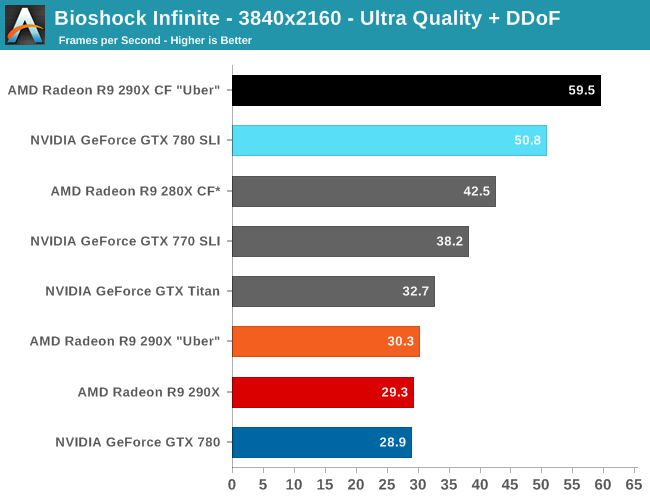

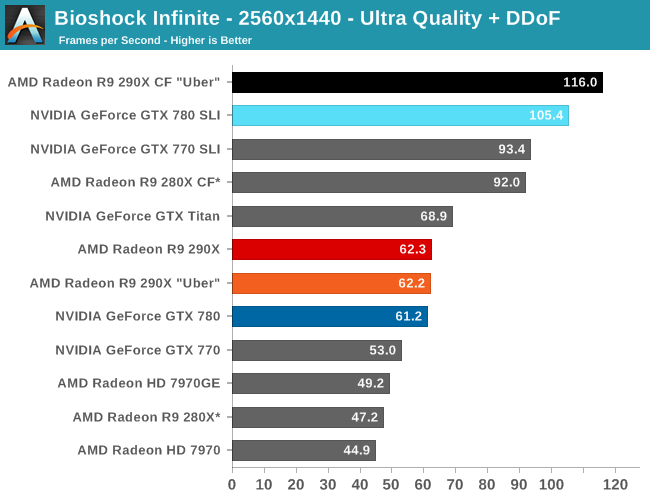
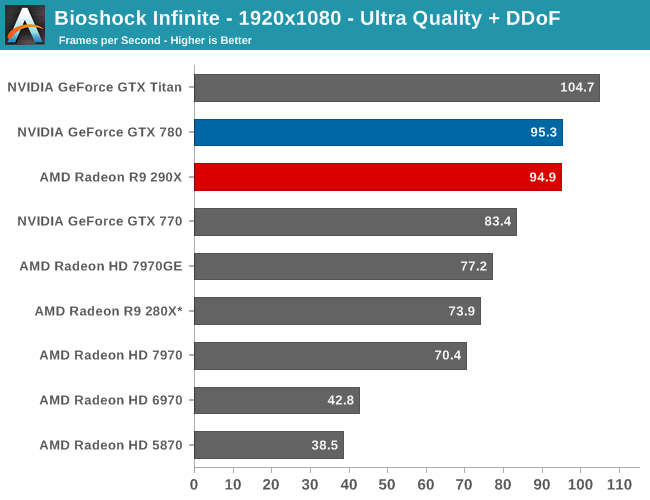
The first of the games AMD allowed us to publish results for, Bioshock is actually a straight up brawl between the 290X and the GTX 780 at 2560. The 290X’s performance advantage here is just 2%, much smaller than the earlier leads it enjoyed and essentially leaving the two cards tied, which also makes this one of the few games that 290X can’t match GTX Titan. At 2560 everything 290X/GTX 780 class or better can beat 60fps despite the heavy computational load of the depth of field effect, so for AMD 290X is the first single-GPU card from them that can pull this off.
Meanwhile at 4K things end up being rather split depending on the resolution we’re looking at. At Ultra quality the 290X and GTX 780 are again tied, but neither is above 30fps. Drop down to Medium quality however and we get framerates above 60fps again, while at the same time the 290X finally pulls away from the GTX 780, beating it by 14% and even edging out GTX Titan. Like so many games we’re looking at today the loss in quality cannot justify the higher resolution, in our opinion, but it presents another scenario where 290X demonstrates superior 4K performance.
For no-compromises 4K gaming we once again turn our gaze towards the 290X CF and GTX 780 SLI, which has AMD doing very well for themselves. While AMD and NVIDIA are nearly tied at the single GPU level – keep in mind we’re in uber mode for CF, so the uber 290X has a slight performance edge in single GPU mode – with multiple GPUs in play AMD sees better scaling from AFR and consequently better overall performance. At 95% the 290X achieves a nearly perfect scaling factor here, while the GTX 780 SLI achieves only 65%. Curiously this is better for AMD and worse for NVIDIA than the scaling factors we see at 2560, which are 86% and 72% respectively.
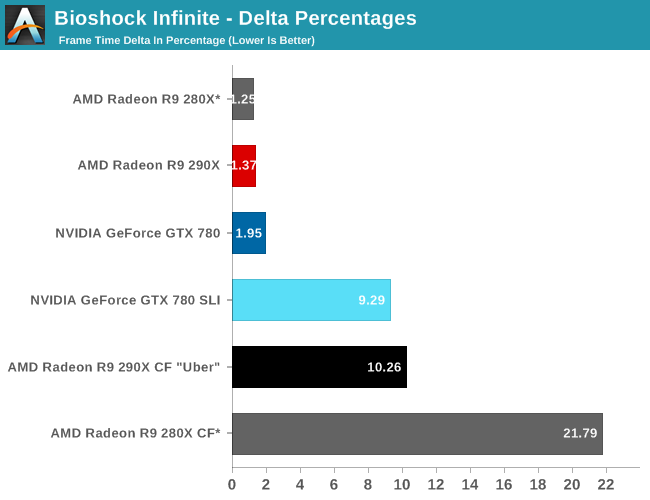

Moving on to our FCAT measurements, it’s interesting to see just how greatly improved the frame pacing is for the 290X versus the 280X, even with the frame pacing fixes in for the 280X. Whereas the 280X has deltas in excess of 21%, the 290X brings those deltas down to 10%, better than halving the variance in this game. Consequently the frame time consistency we’re seeing goes from being acceptable but measurably worse than NVIDIA’s consistency to essentially equal. In fact 10% is outright stunning for a multi-GPU setup, as we rarely achieve frame rates this consistent on those setups.
Finally for 4K gaming our variance increases a bit, but not immensely so. Despite the heavier rendering workload and greater demands on moving these large frames around, the delta percentages keep to 13%.


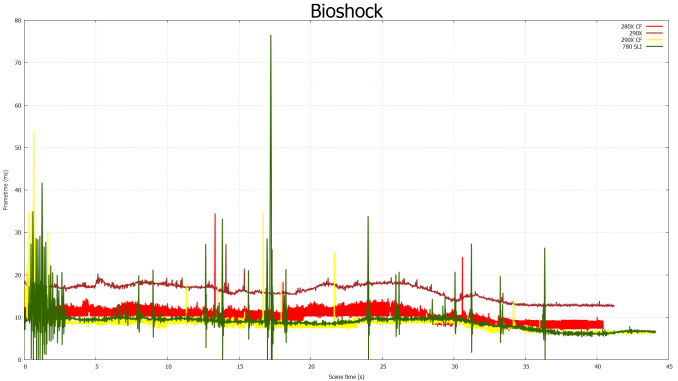









396 Comments
View All Comments
xres625e - Thursday, October 24, 2013 - link
sterven..eddieveenstra - Sunday, October 27, 2013 - link
stoere jongen ben je.... bah.TrantaLocked - Sunday, October 27, 2013 - link
Hm I wonder why I can find the 290X for $550 on newegg?Dal Makhani - Thursday, October 24, 2013 - link
lol AMD fanboy. This card is alright, nothing "uber". It brings some proper pricing sense back into the green team's head which is needed, the gtx 780 will be dropped to R9 290X pricing, and the 780 Ti will be Nvidia's new 650 dollar card. But to justify 100 dollar price difference, i dont know if 780 Ti can show big enough gains. That will be interesting to see next month.tuklap - Thursday, October 24, 2013 - link
I doubt that nvidia gtx 780 will drop price on par with r9 290x..just4U - Thursday, October 24, 2013 - link
I doubt it as well.. They didn't ever really drop prices on the 560Ti until it EOL..mfergus - Thursday, October 24, 2013 - link
Well it's uber in the sense that it brings much needed competition to Nvidia's very high priced high end cards. Nobody should of thought this card was going to be revolutionary though, it's on the same 28nm as all the other cards and it has the same architecture as the 7790 which had very minor compute changes compared to GCN 1.0dragonsqrrl - Thursday, October 24, 2013 - link
Dropping the 780 by $100 is the very least Nvidia would have to do to remain competitive, and personally I don't think that would be nearly enough. The 290X is performance competitive with Titan, and despite the fact that Titan is cooler, quieter, consumes less power, has a much better shroud, and superior DP performance, it should come down to the same price as the 290X to remain competitive due to the slightly higher performance of the 290X. A ~$550 Titan or ~$400 780 would be amazing.mfergus - Thursday, October 24, 2013 - link
I don't expect Titan's price to change much but I could be wrong. I never really thought of it as a standard gaming card, it's a total halo product with lots of memory and the only non Quadro/Tesla with full DP performance. The 780ti will be cheaper than Titan though and faster in gaming performance.Bloodcalibur - Thursday, October 24, 2013 - link
You truly are an idiot if you think that the Titan should be compared to a 290X and that the sentence ends there. The Titan itself only performs a small bit above nvidia's own 780, but the $350 price difference is there for it's compute performance. It's basically a budget workstation card with higher than 780 gaming abilities for those who game AND do a little bit of 3D computing. Derp.This retard actually suggested a gaming/workstation hybrid pried at $1000 should compete downwards with a $550 gaming card.